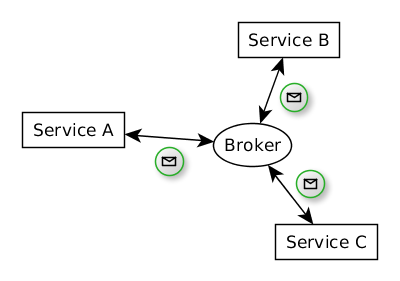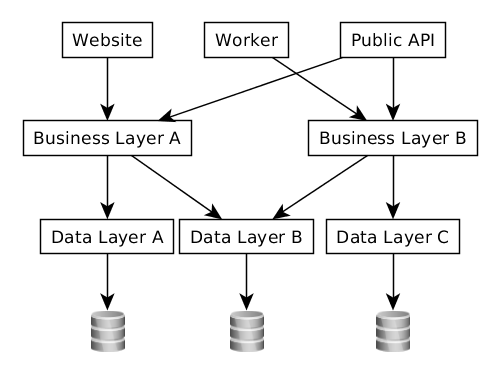Micro-services at BlaBlaCar
Going international comes with a bunch of technical challenges that need to be addressed early. How do we easily scale our platform? How do we provide our service to users who are thousands of kilometers away? How do we ensure that everything goes smoothly with our constant delivery processes?
To answer all these questions we must adopt a global technical strategy which gives us enough flexibility each and every day. Like many other platforms, our service is mainly structured around a main functional brick, with a few smaller ones gravitating around. That is why we are currently working on slicing our monolithic application into smaller, independent functional bricks. But what does independent mean?
In a user-centric application where everything is connected, how do you trace relevant boundaries and decide what can be isolated and what cannot?
Event sourcing
Although there is no simple answer, we must first ask ourselves how we would like to make our hypothetical different services talk to each others. At some point, user actions will have to trigger background operations. If you take the time to list these operations, and the way they are connected to each other, you will most likely end up with a spaghetti bowl, where nothing seems to be independent enough to be isolated.
At this point you’ll have basically two choices: let things globally untouched, or review the way you allow things to communicate between them. Since the first solution is not an option, we specified inter-service communication around two axes:
- A service should never ask directly another service to perform business operations, it may only ask for data which is meaningful to perform its own operations;
- A service may trigger an event whenever an operation is processed to notify every other service that might be interested that some operation was processed. These services will then be able to trigger operations of their own, with their own language and logic, completely independently from one another.
This can be done by using a messaging system (or message broker), where every service may publish into or consume from. This allows to drastically reduce the coupling between services. At BlaBlaCar, we use RabbitMQ.

Specialized layers
But while event sourcing allows us to design independent services, we still have no precise idea of what these services should look like. Indeed, we may have identified a bunch of functional bricks which may be isolated from one another, but what about the data? Going international will raise issues regarding data access from multiple countries and services, and we need to find a way to make data available.
For these reasons, we imagined a global architecture made of three specialized layers:
1. Application
Basically any client which requires functionality or data. The application is responsible for routing the client request, asking layers below for a functionality, and formatting an understandable response. At BlaBlaCar, we work with multiple applications:
- our main Symfony2 application (the website),
- our public API (the entry-point for mobile apps),
- a bunch of workers (to perform asynchronous tasks)…
Each of these applications has its own needs and should therefore ask for operations to the appropriate services.
The application layer, being responsible for aggregating calls to different services, may also provide the user with partial functionality, in case of unavailability from one service.
2. Business
Contains the whole domain logic. It acts as the middleware between application and data. It enforces the business rules, and is described using a language understandable by everyone. With that in mind, domain-driven design (DDD) offers a good starting point to describe and partially implement the boundaries we designed. Using DDD, we are able to imagine effectively the concepts that need to be dealt with by refocusing on their true meaning.
Business layers are kept simple and focus only on pure business processes.
3. Data
Contains access methods to our data back-ends. Each data type has its own entry point, allowing us to easily switch from one back-end to another that may use a different technology. Communication between data layers is not allowed: if a business functionality requires data from multiple storages, it must be responsible for aggregating it according to its needs. This obviously raises questions such as pagination capabilities, and at some point, technical choices we make will have an impact on the product. For this reason, it is mandatory to raise awareness of technical constraints we face and to make them understandable for everyone.

Think API
By thinking micro-services, the idea behind is that each part should provide a generic interface to allow easy inter-communication. Although business layers may only communicate with each other through event sourcing, there is still the need to actually call the different business and data methods, directly from some application code if the layer is a dependency (a vendor of some worker for instance), or through an HTTP client if it is on a remote location (which is what we are aiming at).
For this reason, every service (business or data) should expose its actions through an API. The client code should have no awareness of the implementations behind the scene, and only requests for business actions or data through this generic interface. This interface is responsible for routing the request towards the appropriate layer.
At BlaBlaCar, we designed this communication with the Request/Handler/Response pattern for the business layer:
- The request encapsulates the client needs and provides access to each attribute. It is easily serializable, in order to be passed through the network;
- The handler performs the actual operation based on the request. Its responsibility is to process the needed operation and to return a response;
- The response encapsulates the result of the business operation and is easily serializable as well. As part of an API-oriented service, it should provide a status code, informing on the operation success or failure, that may be translated into HTTP code for instance.

Conclusion
As of now, we support our international growth by isolating our services one step at at time. By thinking micro-services, we force ourselves to imagine things globally and to abstract the layers involved.
Among all the technical challenges which are faced during this research phase, the major difficulty is probably to make it a global concern, because everyone involved will hit the wall at some point.





